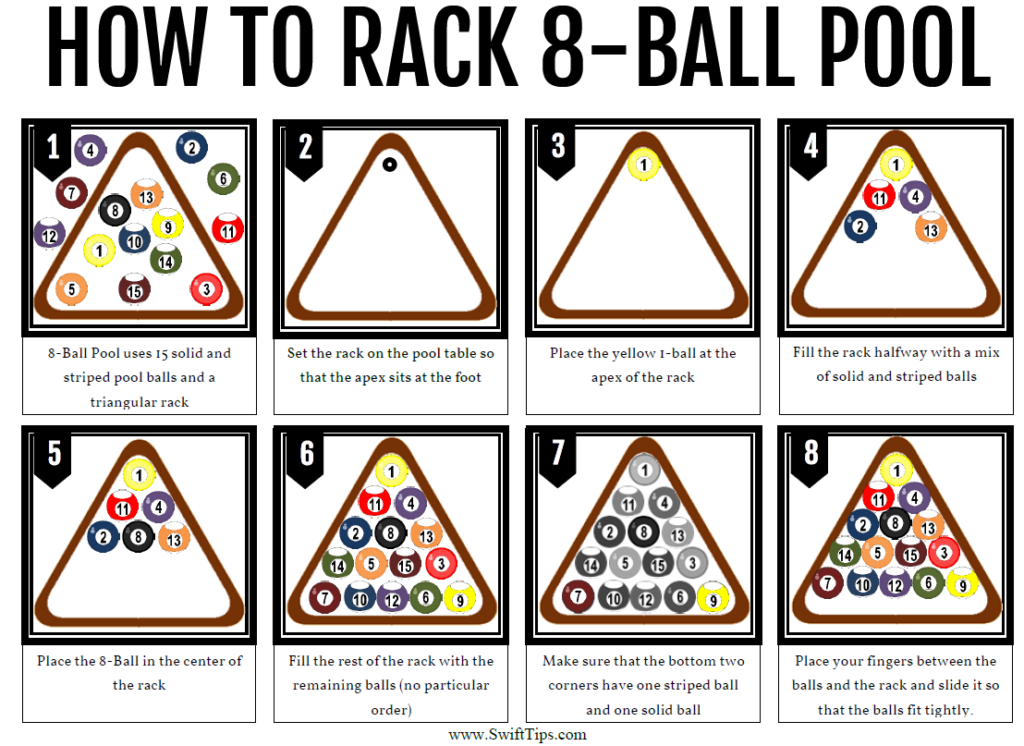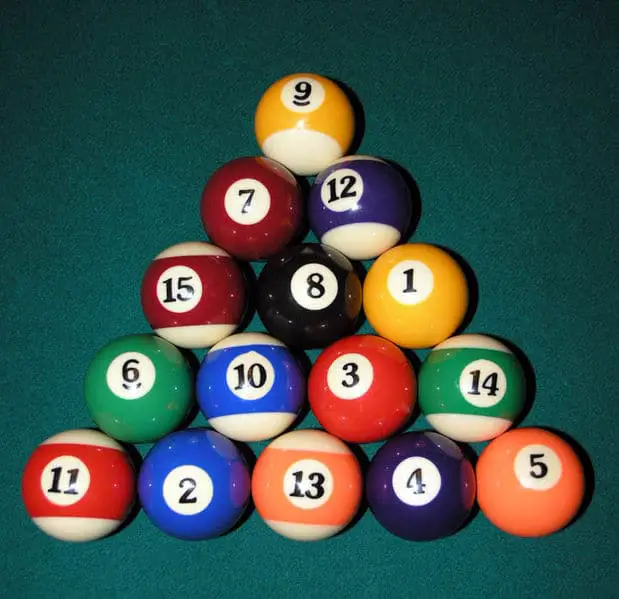Ever wondered how a perfect break in a game of pool is achieved, that moment of satisfying chaos when the balls scatter across the felt? The secret lies not just in the power of the cue, but in the art of the rack the initial formation that dictates the entire game.
The process of racking might seem deceptively simple, but its a fundamental skill that underpins every shot, every strategic decision, and ultimately, every victory. A poorly racked game can lead to an uneven break, leaving you at a disadvantage from the very beginning. Conversely, a meticulously crafted rack can set the stage for a dominating performance.
Let's delve into the world of pool racking, exploring its nuances and uncovering the techniques that will elevate your game. Well unravel the secrets behind creating a tight and legal rack, explore the different formations needed for various pool games, and address common questions that even seasoned players ponder. So, get ready to sharpen your cue and dive deep into the intricate world of pool racking.
Before we proceed, it's useful to understand the basic structure of a pool table. Though not a technical term, it is essential to grasp the different sections of a pool table for future reference. This includes the foot spot (where the rack is centered), the head spot (opposite the foot spot), the rails, the pockets, and the playing surface, or the felt.
The "rack," as it's commonly known, serves as a guide. It is a frame, typically triangle-shaped (more common) or diamond-shaped, made from plastic, wood, or metal. It is used for arranging the billiard balls in a precise formation before the break shot. The primary purpose of the rack is to arrange the balls tightly together, ensuring that they spread evenly and unpredictably when struck by the cue ball. This compact, triangular arrangement helps set up the balls correctly, crucial for a fair and balanced game, giving both players an equal opportunity to begin.
The significance of a proper billiard rack cannot be overstated. Racking the balls correctly is about more than just aesthetics; it's about ensuring the integrity and quality of the game. It impacts the initial break, the spread of the balls, and the potential for scoring. Racking well can translate into the feel of being in command as the game begins.
| Feature | Details |
|---|---|
| What is a Pool Rack? | A triangle or diamond-shaped frame (typically plastic, wood, or metal) used to arrange billiard balls before the break. |
| Purpose | To create a tight formation, ensuring balls spread evenly and unpredictably upon the break. |
| Importance | Crucial for a fair break, balanced game, and overall quality of play. |
| Main Purpose | To arrange the balls in a tight formation. |
To ensure the highest quality of the game, the racking must be set up correctly. Each game has its own pool balls order and method to rack the balls.
There are different racks for different pool games, but the core principle remains the same: achieve a tight, legal formation.
The fundamental objective when racking pool balls is to ensure the balls are packed tightly together within the rack. This is because a tight rack transfers energy more efficiently from the cue ball during the break shot, resulting in a more dynamic and unpredictable spread of the balls across the table.
A well-executed rack sets the stage for a balanced break, where the balls are spread evenly across the table, increasing the odds of a fair game. Conversely, a loose or improperly arranged rack can result in a less effective break, leading to a skewed distribution of the balls, possibly giving one player an advantage.
The most common rack is the triangle shape, typically used for games like 8-ball and straight pool. This classic shape is designed to hold and organize the balls in a compact, triangular formation. This is typically placed on the foot spot on one end of the table. The base of the rack should be parallel to the short end of the table, with the apex (tip) of the triangle precisely on the foot spot, a point typically marked with a dot of some sort on the pool table.
In pool, billiard, and snooker, the rack serves as a guide for arranging the balls in a tight formation before breaking.
The process is as follows: Place the triangle rack on the pool table and arrange all fifteen balls randomly within the rack. Arrange the remaining balls randomly for tight packing and a balanced break.
When it comes to the specifics, different games require different arrangements. For instance:
In 8-ball, the 8-ball should be in the center of the rack. One corner must have a solid ball, the other corner must have a stripe ball.
In straight pool, the balls are arranged in no specific order, but they must be packed tightly, and the apex ball is placed on the foot spot.
To win the straight pool game, you need to reach on a specified quantity of points.
Another popular game is Cutthroat.
For Cutthroat pool, the balls are racked at random, with each player assigned a group of balls. The objective is to pocket all of your opponents' balls before they pocket all of yours. The racking method is the same as for 8-ball.
How do you correctly rack pool balls? Well, you correctly rack the pool balls by following various standards from different national and international associations, and game types.
If you are a beginner pool player or need to brush up on the rack set up for different pool games, you have come to the right place too.
Luckily, learning how to rack pool balls properly is not hard, and we have laid out everything you need to know right here.
In seconds, you can quickly arrange nine balls in diamond form. If you only have a triangle rack for 15 balls, dont worry! You can shape them into a diamond through 3 steps:
In essence, mastering the art of the rack involves understanding the various formations, the importance of tightness, and the subtle nuances that distinguish a good break from a great one.



Detail Author:
- Name : Kailyn Bartoletti IV
- Email : morissette.betty@franecki.com
- Birthdate : 1987-06-01
- Address : 65324 Michaela Plaza Stoltenbergview, ME 30907-2944
- Phone : (360) 571-3718
- Company : Homenick-Rice
- Job : Forming Machine Operator
- Bio : Id molestias iste aut libero ut corrupti reiciendis. Molestiae aut impedit aliquid optio ab sed. Vel sint iure repellendus qui et animi dolorem. Natus dicta blanditiis et fugit ut eveniet est dolor.